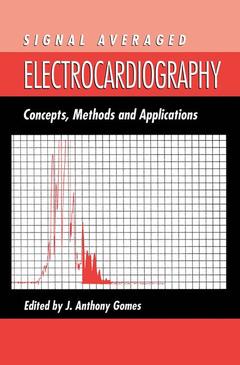Description
Signal Averaged Electrocardiography, 1993
Concepts, Methods and Applications
Author: Gomes J.A.
Language: English
Subject for Signal Averaged Electrocardiography:
Publication date: 10-2012
583 p. · 15.5x23.5 cm · Paperback
583 p. · 15.5x23.5 cm · Paperback
Description
/li>Contents
/li>
This book deals with the basic concepts of high resolution electrocardiography: the electrophysiological basis of late potentials, mechanism of arrhythmias, the different methods of recording and analysis of high resolution, signal processed electrocardiograms and their clinical applications.
This is a new edition and is more up-to-date, provides more clinical utility and addresses more basic concepts of the electrophysiology of re-entrant arrhythmias than any other book published in the same field. The book will appeal to cardiologists (academic and clinical), electrophysiologists, technicians and engineers working in the field of computerized electrocardiography and in industry.
This is a new edition and is more up-to-date, provides more clinical utility and addresses more basic concepts of the electrophysiology of re-entrant arrhythmias than any other book published in the same field. The book will appeal to cardiologists (academic and clinical), electrophysiologists, technicians and engineers working in the field of computerized electrocardiography and in industry.
1. The signal averaged ECG: a historical perspective.- 2. Pathophysiology of late potentials.- 3. Electrophysiological mechanisms of reentrant ventricular tachyarrhythmias.- 4. The methods of recording and analysis of the signal averaged ECG.- 5. The vector magnitude, time domain analysis and standards for late potentials.- 6. Frequency domain analysis.- 7. Spectrotemporal mapping of the surface ECG for detection of ventricular late potentials.- 8. Spectral turbulence analysis.- 9. Body surface mapping of late potentials.- 10. Twenty-four hour analysis for late potential activity: method and implications.- 11. Beat-by-beat recording of high resolution ECG: technical considerations.- 12. Importance of noise reduction for signal averaged electrocardiography.- 13. Reproducibility and variation in assessing late potentials.- 14. The signal averaged ECG in the detection of sinus atrial abnormalities.- 15. Clinical significance of high resolution electrocardiography — sinus node, His bundle and ventricular late potentials.- 16. The role of signal averaged ECG in detecting tachycardias.- 17. The signal averaged ECG in patients with sustained ventricular tachycardia in the setting of coronary artery disease.- 18. The signal averaged ECG in patients with cardiomyopathy.- 19. The signal averaged ECG in patients with sustained ventricular tachycardia and no evidence of heart disease.- 20. The effect of myocardial resection on the signal averaged ECG.- 21. The signal averaged ECG in patients with bundle branch block.- 22. The signal averaged ECG in the diagnosis of syncope.- 23. Use of the signal averaged ECG in the management of nonsustained ventricular tachycardia.- 24. Role of the signal averaged ECG in patients without coronary artery disease and nonsustained ventriculartachycardia.- 25. The signal averaged ECG in patients with nonsustained ventricular tachycardia — a perspective.- 26. Natural history of late potentials after myocardial infarction.- 27. Risk stratification post myocardial infarction identification of patients at high risk of sudden cardiac death.- 28. The effect of reperfusion on the signal averaged ECG.- 29. Modulating effect of ischemia on late potentials.- 30. The signal averaged ECG in detecting coronary artery disease.- 31. Assessment of risk of ventricular arrhythmias and value of signal averaged electrocardiography in hypertrophic cardiomyopathy.- 32. The effect of antiarrhythmic drugs on the signal averaged ECG. Does it predict response to therapy?.- 33. Spectral analysis of the surface ECG for non-invasive detection of acute rejection after heart transplantation.- 34. Electrical alternans of the surface ECG: detection methods and relation to arrhythmia vulnerability.
© 2024 LAVOISIER S.A.S.




